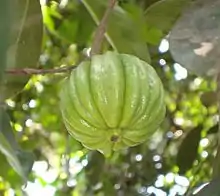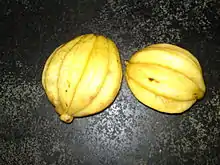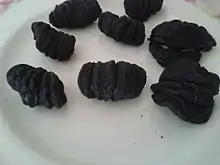Garcinia gummi-gutta
Garcinia gummi-gutta is a tropical[2] species of Garcinia native to Indonesia. Common names include Garcinia cambogia (a former scientific name), as well as brindleberry,[3] Malabar tamarind,[2] and kudam puli (pot tamarind).[4] The fruit looks like a small pumpkin and is green to pale yellow in color.
| Garcinia gummi-gutta | |
|---|---|
 | |
| Scientific classification | |
| Kingdom: | Plantae |
| Clade: | Tracheophytes |
| Clade: | Angiosperms |
| Clade: | Eudicots |
| Clade: | Rosids |
| Order: | Malpighiales |
| Family: | Clusiaceae |
| Genus: | Garcinia |
| Species: | G. gummi-gutta |
| Binomial name | |
| Garcinia gummi-gutta | |
| Synonyms[1] | |
| |
Although it has received considerable media attention purporting its effects on weight loss, there is liver toxicity associated with commercial preparations of the fruit extract,[5] with clinical evidence indicating it has no significant effect on weight loss.[6][7]
Cultivation

Garcinia gummi-gutta is grown for its fruit in Southeast Asia, coastal Karnataka/Kerala, India, and west and central Africa. It thrives in most moist forests.
Garcinia gummi-gutta is one of several closely related Garcinia species from the plant family Clusiaceae.[8] With thin skin and deep vertical lobes, the fruit of G. gummi-gutta and related species range from about the size of an orange to that of a grapefruit; G. gummi-gutta looks more like a small yellowish, greenish, or sometimes reddish pumpkin.[9] The color can vary considerably. When the rinds are dried and cured in preparation for storage and extraction, they are dark brown or black in color.
Along the west coast of South India, G. gummi-gutta is popularly termed "Malabar tamarind", and shares culinary uses with the tamarind (Tamarindus indica). The latter is a small and the former a quite large evergreen tree. G. gummi-gutta is also called goraka or, in some areas, simply kattcha puli (souring fruit). It is called uppage in Kannada language and fruits are collected and dried for selling to dealers in Sirsi, Karnataka.[10]
Phytochemicals
Although few high-quality studies have been done to define the composition of the fruit, its phytochemical content includes hydroxycitric acid which is extractable and developed as a dietary supplement.[6][11] Other compounds identified in the fruit include the polyphenols, luteolin, and kaempferol.[12]
Weight loss claims
In late 2012, a United States celebrity doctor, Dr. Oz, promoted Garcinia cambogia extract as "an exciting breakthrough in natural weight loss".[13][14] Dr. Oz's endorsements of dietary supplements having no or little scientific evidence of efficacy have often led to a substantial increase in consumer purchases of the promoted products.[14]
While it has received considerable media attention purporting impact on weight loss, the evidence for Garcinia cambogia supports no clear effect,[15] while gastrointestinal adverse events were two-fold more common over the placebo in a 2011 meta-analysis, indicating the extract may be unsafe for human consumption.[6] Adverse events associated with use of such supplements ("side effects") — especially, liver toxicity, as well as gastrointestinal issues — led to one preparation being withdrawn from the market.[5]
Adverse effects
Hydroxycitric acid can cause dry mouth, nausea, gastrointestinal discomfort, and headaches.[16][17]
Drug interactions
There is potential for Garcinia cambogia to interfere with prescription medications, including those used to treat people with diabetes, asthma, and clotting disorders.[7]
Culinary

Garcinia gummi-gutta is used in cooking, including in the preparation of curries. The fruit rind and extracts of Garcinia species are called for in many traditional recipes,[18] and various species of Garcinia are used similarly in food preparation in Assam (India), Thailand, Malaysia, Burma, and other Southeast Asian countries. In the Indian Ayurvedic medicine, "sour" flavors are said to activate digestion. The extract and rind of G. gummi-gutta is a curry condiment in India.[4][18][19][20] It is an essential souring ingredient in the southern Thai variant of kaeng som, a sour curry.[21][22]
Gallery
 Cross section
Cross section Drying in smoke
Drying in smoke
See also
References
- "Garcinia gummi-gutta (L.) N.Robson". World Checklist of Selected Plant Families (WCSP). Royal Botanic Gardens, Kew. Retrieved 1 June 2013 – via The Plant List.
- "Garcinia gummi-gutta". Germplasm Resources Information Network (GRIN). Agricultural Research Service (ARS), United States Department of Agriculture (USDA). Retrieved 11 December 2017.
- Tinworth, Kellie D; Harris, Patricia A; Sillence, Martin N; Noble, Glenys K (2010). "Potential treatments for insulin resistance in the horse: A comparative multi-species review". The Veterinary Journal. 186 (3): 282–291. doi:10.1016/j.tvjl.2009.08.032. PMID 19783461.
- Basu, Abhishek (2010-07-14). "Meals that heal - Soul curry". The Hindu. Retrieved 3 October 2013.
- Lobb, A. (2009). "Hepatoxicity associated with weight-loss supplements: A case for better post-marketing surveillance". World Journal of Gastroenterology. 15 (14): 1786–1787. doi:10.3748/wjg.15.1786. PMC 2668789. PMID 19360927.
- Onakpoya, Igho; Hung, Shao Kang; Perry, Rachel; Wider, Barbara; Ernst, Edzard (2011). "The Use of Garcinia Extract (Hydroxycitric Acid) as a Weight loss Supplement: A Systematic Review and Meta-Analysis of Randomised Clinical Trials". Journal of Obesity. 2011 (December 14): 509038. doi:10.1155/2011/509038. PMC 3010674. PMID 21197150.
- "Garcinia cambogia". Drugs.com. 11 May 2016. Retrieved 12 May 2018.
- Publications & Information Directorate, Council of Scientific & Industrial Research (1986). G. cambogia Desr. The Useful Plants of India. (New Delhi: Publications & Information Directorate, 1986) 229.
- "Fruit yellowish or reddish, size of an orange having six or eight deep longitudinal grooves in its fleshy pericarp. Pulp acid of a pleasant flavor. It is dried among the Singalese who use it in curries." Uphof, J.C. Th. (1968).
- Rajeswari, N (29 July 2014). "Botanical Bonanza". Deccan Herald, Spectrum. Retrieved 29 July 2014.
- Yamada T, Hida H, Yamada Y (2007). "Chemistry, physiological properties, and microbial production of hydroxycitric acid". Appl. Microbiol. Biotechnol. 75 (5): 977–82. doi:10.1007/s00253-007-0962-4. PMID 17476502.
- Sulaiman, C. T; Balachandran, I (2017). "LC/MS characterization of phenolic antioxidants of Brindle berry (Garcinia gummi-gutta (L.) Robson)". Natural Product Research. 31 (10): 1191–1194. doi:10.1080/14786419.2016.1224871. PMID 27583573.
- The Dr. Oz Show (November 5, 2012). Garcinia Cambogia: The Newest, Fastest Fat-Buster Archived 2014-04-21 at the Wayback Machine.
- Christensen, Jen; Wilson Jacque (19 June 2014). "Congressional hearing investigates Dr. Oz 'miracle' weight loss claims". CNN Health. Retrieved 18 September 2016.
- Heymsfield, S. B.; Allison, D. B.; Vasselli, J. R.; Pietrobelli, A.; Greenfield, D.; Nunez, C. (1998). "Garcinia cambogia (Hydroxycitric Acid) as a Potential Antiobesity Agent: A Randomized Controlled Trial". J. Am. Med. Assoc. 280 (18): 1596–1600. doi:10.1001/jama.280.18.1596. PMID 9820262.
- Soni, MG (2004). "Safety assessment of (-)-hydroxycitric acid and Super CitriMax, a novel calcium/potassium salt". Food Chem Toxicol. 42 (9): 1513–29. doi:10.1016/j.fct.2004.04.014. PMID 15234082.
- "Garcinia (hydroxycitric acid)". Drugs.com. 14 May 2018. Retrieved 23 August 2018.
- "The acid rinds of the ripe fruit are eaten, and in Ceylon are dried, and eaten as a condiment in curries." Drury, Heber (1873). "Garcinia gambogia (Desrous) N. 0. Clusiaceae". The Useful Plants of India, second edition. London: William H. Allen & Co. p. 220.
- "G. Gummi-Gutta (Garcinia Cambogia) – An Ancient Indian Curry Condiment". US Premium Garcinia Cambogia. Retrieved 5 May 2015.
- "Kudampuli meencurry (fish curry with Malabar tamarind)". Secret Indian Recipe. Retrieved 5 May 2015.
- "Kaeng Som Kung (Sour Curry with Shrimp)". Saveur. 26 February 2015. Retrieved 5 May 2015.
- "Gaeng Som Recipe, Thai Sour Curry Recipe of Shrimp, Okra and Roselle Leaves". Thai Food Master. 30 March 2011. Retrieved 5 May 2015.
External links
| Wikimedia Commons has media related to Garcinia gummi-gutta. |
